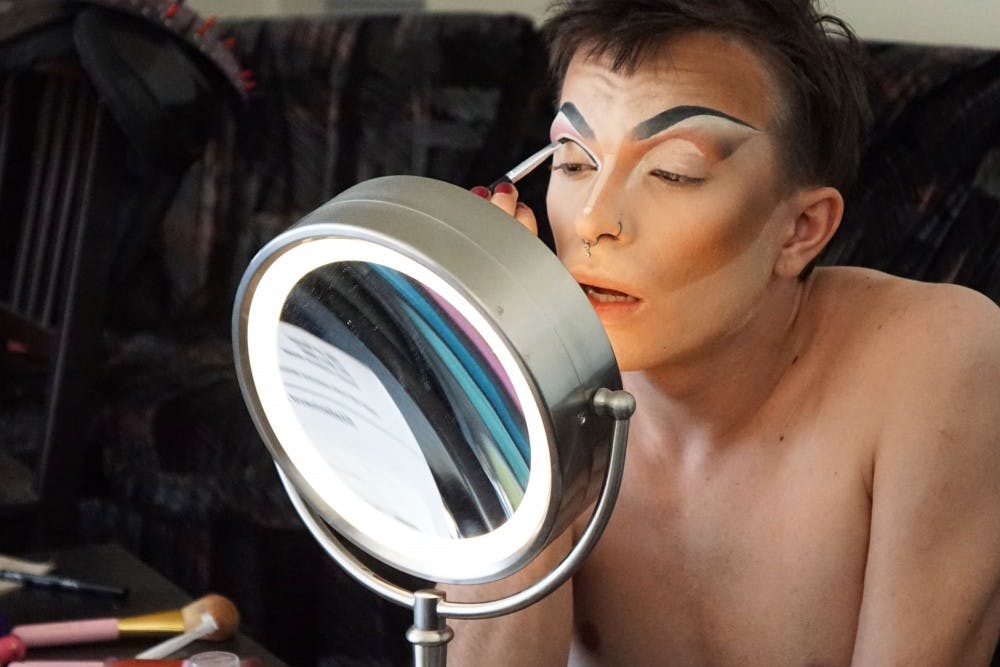It's hard to deny the skill required for the meticulous stroke of an eyebrow line or the calculated application of makeup in a drag transformation. And it seems that as drag culture gains more popularity, the lines between drag and fine art blur.
Drag culture, made more popular in recent years through mainstream coverage like “RuPaul's Drag Race,” is often associated with shocking fashion and colorful makeup. However, drag is more than just the glamor seen on stage — it is an accumulation of artistry, history and self-expression.
Performance junior Marcus Leatham goes by Astrud Aurelia on stage and has been heavily involved in the local drag community since June of last year.
“When Astrud was born, it was a very freeing moment for me as a person and as an artist,” Leatham said.
Makeup alone can take anywhere from an hour to three hours, sometimes longer. Finding the components for an outfit is a lengthy process, and some more experienced drag artists create new outfits from scratch for every performance. Warming up is often necessary as high-energy performances require physical finesse and difficult maneuvers.
Besides artistic presentation, one of the most precious aspects of drag to a performer is the name they adopt. The name may represent their identity, so many in the culture hold a performer’s name in high respect, Leatham said.
“For a lot of people, that name might end up being their actual name,” Leatham said. “That queen that you met, they may end up being that name all the time.”
Drag contains breadth and depth due to its representation of gender and sexuality and allows those in the LGBT+ community to have access to a stage for self-expression and a strong support network.
Leatham said that Astrud Aurelia recently became the drag daughter of local drag star Dahli. The culture of mentorship is another big aspect of drag, drawing its roots from the underground house ball culture of New York’s early LGBT+ night scene which gained notoriety during the Harlem Renaissance of 1920.
“It was about showing up as whatever person in society you wished you could be that society wouldn’t let you be,” Leatham said. “Because you were gay or because you were black.”
People that participated in the pageant-like events would be adopted into a house if they won a trophy for a category they competed in, Leatham said, and once adopted, more experienced members of the house would help guide new artists.
Similarly, modern drag families exist to help support one another and teach beginners and promising talent how to succeed.
Students from ASU West’s LGBT+ organization Spectrum are trying to find their own success as beginning drag performers as they prepare for their drag show on April 11.
Read More: ASU LGBT clubs collaborate to celebrate Pride Week this spring
Rachael King, a freshman environmental science major, will be performing a show with two other club members, and said that she got interested in the culture after having been taught colorguard and dance by a well known drag performer from her hometown of Seattle, where drag is more prominent.
“Coming from an area with more of a drag culture to here, I can tell it is more subdued,” King said. “I think a lot of people don’t understand what it is.”
John Payton, a history junior, said what people really need to understand about drag is that it is actually all around us.
“Even for people who don’t know drag, you’re doing drag on a daily basis,” Payton said. “Everyday you get dressed and put on clothes to fit an image, to portray something that society is telling you to portray, you’re doing drag.”
In the words of RuPaul, the host of the popular "Drag Race" show: “We’re born naked, and the rest is drag.”
Leatham said his next personal step is bringing drag to the broader community.
“Get it out of the gay bar,” Leatham said. “I want to put it in art museums, I want to put it in straight venues, I want to put it in music venues."
Reach the reporter at qbingham@asu.edu or follow @quintinbingham on Twitter.
Like The State Press on Facebook and follow @statepress on Twitter.




